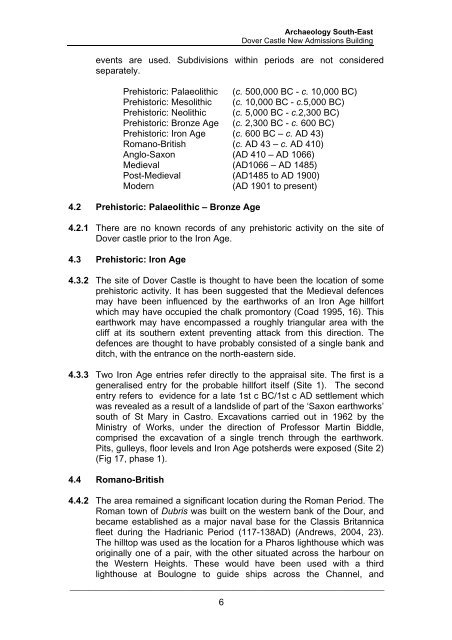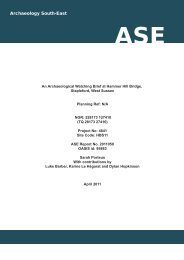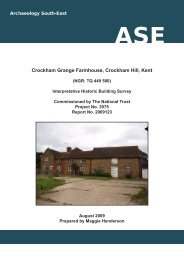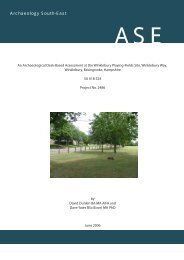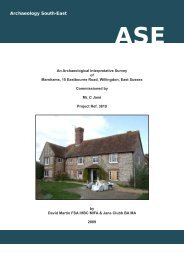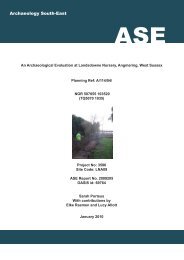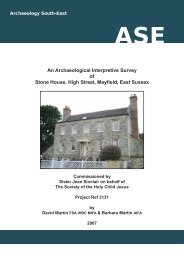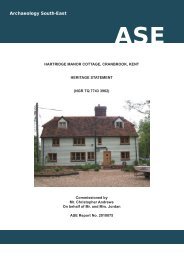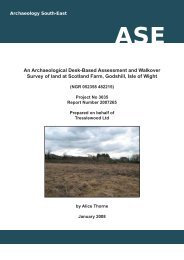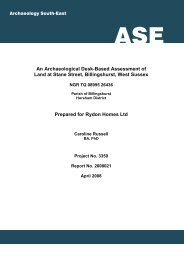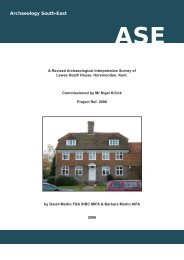ASE front cover 3127 Dover Castle - Archaeology South-East
ASE front cover 3127 Dover Castle - Archaeology South-East
ASE front cover 3127 Dover Castle - Archaeology South-East
You also want an ePaper? Increase the reach of your titles
YUMPU automatically turns print PDFs into web optimized ePapers that Google loves.
<strong>Archaeology</strong> <strong>South</strong>-<strong>East</strong><strong>Dover</strong> <strong>Castle</strong> New Admissions Buildingevents are used. Subdivisions within periods are not consideredseparately.Prehistoric: PalaeolithicPrehistoric: MesolithicPrehistoric: NeolithicPrehistoric: Bronze AgePrehistoric: Iron Age (c. 600 BC – c. AD 43)Romano-British (c. AD 43 – c. AD 410)Anglo-Saxon (AD 410 – AD 1066)Medieval (AD1066 – AD 1485)(c. 500,000 BC - c. 10,000 BC)(c. 10,000 BC - c.5,000 BC)(c. 5,000 BC - c.2,300 BC)(c. 2,300 BC - c. 600 BC)Post-Medieval (AD1485 to AD 1900)Modern(AD 1901 to present)4.2 Prehistoric: Palaeolithic – Bronze Age4.2.1 There are no known records of any prehistoric activity on the site of<strong>Dover</strong> castle prior to the Iron Age.4.3 Prehistoric: Iron Age4.3.2 The site of <strong>Dover</strong> <strong>Castle</strong> is thought to have been the location of someprehistoric activity. It has been suggested that the Medieval defencesmay have been influenced by the earthworks of an Iron Age hillfortwhich may have occupied the chalk promontory (Coad 1995, 16). Thisearthwork may have encompassed a roughly triangular area with thecliff at its southern extent preventing attack from this direction. Thedefences are thought to have probably consisted of a single bank andditch, with the entrance on the north-eastern side.4.3.3 Two Iron Age entries refer directly to the appraisal site. The first is ageneralised entry for the probable hillfort itself (Site 1). The secondentry refers to evidence for a late 1st c BC/1st c AD settlement whichwas revealed as a result of a landslide of part of the ‘Saxon earthworks’south of St Mary in Castro. Excavations carried out in 1962 by theMinistry of Works, under the direction of Professor Martin Biddle,comprised the excavation of a single trench through the earthwork.Pits, gulleys, floor levels and Iron Age potsherds were exposed (Site 2)(Fig 17, phase 1).4.4 Romano-British4.4.2 The area remained a significant location during the Roman Period. TheRoman town of Dubris was built on the western bank of the Dour, andbecame established as a major naval base for the Classis Britannicafleet during the Hadrianic Period (117-138AD) (Andrews, 2004, 23).The hilltop was used as the location for a Pharos lighthouse which wasoriginally one of a pair, with the other situated across the harbour onthe Western Heights. These would have been used with a thirdlighthouse at Boulogne to guide ships across the Channel, and_____________________________________________________________________6


